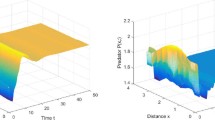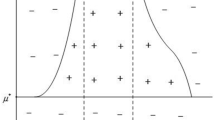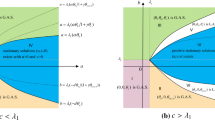Abstract
An intraguild predation model with intraguild predator diffusion is proposed and studied in this work. It is shown that the local system can have four boundary equilibria and at most two interior equilibria. The interior equilibria may exist even when the system is not uniformly persistent. When only intraguild predator diffusion is incorporated into our three-species model, the resulting model is a partially degenerate reaction-diffusion system. For this partially degenerate system, we show that the solution semiflow is bounded dissipative and the positive orbits of bounded sets are bounded. We also demonstrate that intraguild predator diffusion can lead to the occurrence of spatially nonhomogeneous oscillations and spatiotemporal chaos. Further, we show that intraguild predator diffusion can induce transitions between spatially homogeneous oscillations, spatially nonhomogeneous oscillations and chaos.










Similar content being viewed by others
References
Abrams PA, Fung SR (2010) Prey persistence and abundance in systems with intraguild predation and type-2 functional responses. J Theor Biol 264:1033–1042
Amarasekare P (2007) Spatial dynamics of communities with intraguild predation: the role of dispersal strategies. Am Nat 170:819–831
Beddington JR (1975) Mutual interference between parasites or predators and its effect on searching efficiency. J Animal Ecol 44:331–340
Conley C (1978) Isolated invariant sets and the Morse index, CBMS regional conference series in mathematics, American Mathematical Society, Providence, R.I. 38
DeAngelis DL, Goldstein RA, Neill R (1975) A model for trophic interaction. Ecology 56:881–892
Drolet D, Barbeau MA, Coffin MRS, Hamilton DJ (2009) Effect of the snail Ilyanassaobsoleta (Say) on dynamics of the amphipod Corophium volutator (Pallas) on an intertidal mudflat. J Exp Mar Biol Ecol 368:189–195
Du Z, Peng R (2016) A priori \(L^{\infty }\) estimates for solutions of a class of reaction-diffusion system. J Math Biol 72:1429–1439
Fedriani JM, Fuller TK, Sauvajot RM, York EC (2000) Competition and intraguild predation among three sympatric carnivores. Oecologia 125:258–270
Freedman HI, Ruan S, Tang M (1994) Uniform persistence and flows near a closed positively invariant set. J Dyn Differ Equ 6:583–600
Freedman HI, Waltman P (1984) Persistence in models of three interacting predator-prey populations. Math Biosci 68:213–231
Guckenheimer T, Holmes P (1983) Nonlinear oscillations, dynamical systems, and bifurcations of vector fields, Appl. Math. Sci. 42. Springer-Verlag, New York
Hale JK (1988) Asymptotic behavior of dissipative systems. American Mathematical Society, Providence
Han R, Dai B (2017) Spatiotemporal dynamics and spatial pattern in a diffusive intraguild predation model with delay effect. Appl Math Comput 312:177–201
Han R, Dai B, Chen Y (2019) Pattern formation in a diffusive intraguild predation model with nonlocal interaction effects. AIP Advances 9:035046
Hastings A, Abbott KC, Cuddington K et al. (2018) Transient phenomena in ecology, Science, 361: eaat6412
Hattaf K, Yousfi N (2015) A generalized HBV model with diffusion and two delays. Comput Math Appl 69:31–40
Henrot A (2006) Extremum problems for eigenvalues of elliptic operators, Front. Math., Birkhäuser Verlag, Basel
Holling CS (1959) The components of predation as revealed by a study of small-mammal predation of the European pine sawfly. Can Ent 91:293–320
Holling CS (1959) Some characteristics of simple types of predation and parasitism. Can Ent 91:385–398
Holling CS (1966) The functional response of invertebrate predators to prey density. Mem Ent Soc Can 98:5–86
Holt RD, Polis GA (1997) A theoretical framework for intraguild predation. Am Nat 149:745–764
Hsu S, Ruan S, Yang T (2015) Analysis of three species Lotka-Volterra food web models with omnivory. J Math Anal Appl 426:659–687
Ji J, Wang L (2022) Competitive exclusion and coexistence in an intraguild predation model with Beddington-DeAngelis functional response. Commun Nonlinear Sci Numer Simul 107:106192
Kang Y, Wedekin L (2012) Dynamics of a intraguild predation model with generalist or specialist predator. J Math Biol 67:1227–1259
Lester PJ, Harmsen R (2002) Functional and numerical responses do not always indicate the most effective predator for biological control: an analysis of two predators in a two-prey system. J Appl Ecol 39:455–468
Lin J, Yang T (2018) Traveling wave solutions for a diffusive three-species intraguild predation model. Int J Biomath 11:1850022
Liu WM (1994) Criterion of Hopf bifurcations without using eigenvalues. J Math Anal Appl 182:250–256
Ma Z, Shu H (2020) Viral infection dynamics in a spatial heterogeneous environment with cell-free and cell-to-cell transmissions. Math Biosci Eng 17:2569–2591
Martin RH, Smith HL (1990) Abstract functional differential equations and reaction-diffusion systems. Trans Amer Math Soc 321:1–44
Morozov A, Abbott K, Cuddington K, Francis T et al (2020) Long transients in ecology: theory and applications. Phys Life Rev 32:1–40
Polis GA, Holt RD (1992) Intraguild predation: the dynamics of complex trophic interactions. Trends Ecol Evol 7:151–154
Polis GA, Myers CA, Holt RD (1989) The ecology and evolution of intraguild predation: potential competitors that eat each other. Annu Rev Ecol Syst 20:297–230
Protter MH, Weinberger HF (2012) Maximum principles in differential equations, Springer
Sen D, Ghorai S, Banerjee M (2018) Complex dynamics of a three species prey-predator model with intraguild predation. Ecol Complex 34:9–22
Shu H, Hu X, Wang L, Watmough J (2015) Delay induced stability switch, multi-type bistability and chaos in an intraguild predation model. J Math Biol 71:1269–1298
Shu H, Ma Z, Wang X, Wang L (2020) Viral diffusion and cell-to-cell transmission: mathematical analysis and simulation study. J Math Pures Appl 137:290–313
Smith HL (1995) Monotone dynamical systems: an introduction to the theory of competitive and cooperative systems. American Mathematical Society, Providence
Smith TM, Smith RL (2014) Elements of ecology, 9th Edition. Pearson
Solomon ME (1949) The natural control of animal populations. J Anim Ecol 19:1–35
Tanabe K, Namba T (2005) Omnivory creates chaos in simple food web models. Ecology 86:3411–3414
Velazquez I, Kaplan D, Velasco-Hernandez JX, Navarrete SA (2005) Multistability in an open recruitment food web model. J Appl Math Comput 163:275–294
Verdy A, Amarasekare P (2010) Alternative stable states in communities with intraguild predation. J Theor Biol 262:116–128
Wang F, Huang Y, Zou X (2014) Global dynamics of a PDE in-host viral model. Appl Anal 93:2312–2329
Wang K, Wang W (2007) Propagation of HBV with spatial dependence. Math Biosci 21:78–95
Wang L, Watmough J, Yu F (2021) Dynamics of a plant-herbivore system with chemically mediated numerical response. Math Appl Sci Eng 2:72–148
Wang X, Zhao X-Q (2015) Pulsating waves of a partially degenerate reaction-diffusion system in a periodic habitat. J Differ Equ 259:7238–7259
Wei H (2019) A mathematical model of intraguild predation with prey switching. Math Comput Simul 165:107–118
Wu Y, Zou X (2018) Dynamics and profiles of a diffusive host-pathogen system with distinct dispersal rates. J Differ Equ 264:4989–5024
Yamaguchi M, Takeuchi Y, Ma W (2007) Dynamical properties of a stage structured three-species model with intra-guild predation. J Comput Appl Math 201:327–338
Yang T, Zhang W, Cheng K (2016) Global dynamics of three species omnivory models with Lotka-Volterra interaction. Discrete Contin Dyn Syst Ser B 21:2867–2881
Yu F, Wang L, Watmough J (2016) Transient spatio-temporal dynamics of a diffusive plant-herbivore system with Neumann boundary conditions. J Biol Dyn 10:477–500
Zhang D, Dai B (2019) A free boundary problem for the diffusive intraguild predation model with intraspecific competition. J Math Anal Appl 474:381–412
Zhang D, Dai B (2019) Spreading and vanishing in a diffusive intraguild predation model with intraspecific competition and free boundary. Math Methods Appl Sci 42:6917–6943
Zhang D, Dai B (2021) The diffusive intraguild predation model with intraspecific competition and double free boundaries. Appl Anal 100:3322–3349
Funding
GL’s work was partially supported by the National Natural Science Foundation of China (No. 12001127) and the Research Project of Guangzhou University (No. RP2021035). AM’s work was partially supported by the National Natural Science Foundation of China (No. 12101547), the Natural Science Foundation of Shanxi Province (No. 201901D111295) and Shanxi Scholarship Council of China (No: 2021-149). JJ acknowledges the support from Dr. William S. Lewis Doctoral Fellowship at the University of New Brunswick. LW’s work was partially supported by the Natural Sciences and Engineering Research Council of Canada (RGPIN-2020-04143).
Author information
Authors and Affiliations
Contributions
All authors contributed to the study conception and design. The first draft of the manuscript was written by Juping Ji and all authors commented on previous versions of the manuscript. All authors read and approved the final manuscript.
Corresponding author
Ethics declarations
Conflict of interest
The authors declare that they have no conflict of interest concerning the publication of this manuscript.
Additional information
Publisher's Note
Springer Nature remains neutral with regard to jurisdictional claims in published maps and institutional affiliations.
Rights and permissions
About this article
Cite this article
Ji, J., Lin, G., Wang, L. et al. Spatiotemporal dynamics induced by intraguild predator diffusion in an intraguild predation model. J. Math. Biol. 85, 1 (2022). https://doi.org/10.1007/s00285-022-01772-w
Received:
Revised:
Accepted:
Published:
DOI: https://doi.org/10.1007/s00285-022-01772-w
Keywords
- Intraguild predation
- Diffusion
- Spatially homogeneous oscillation
- Spatially nonhomogeneous oscillation
- Spatiotemporal chaos




